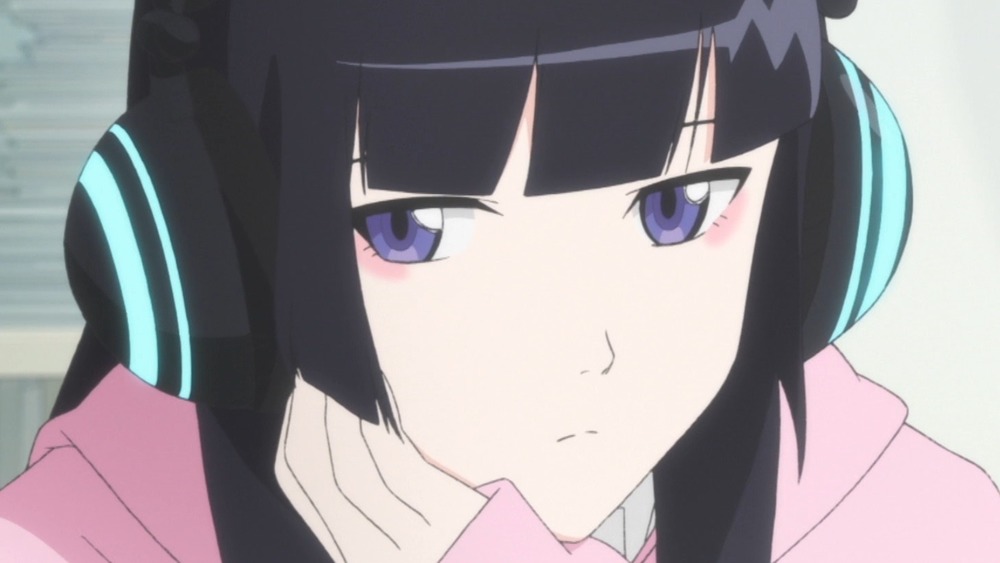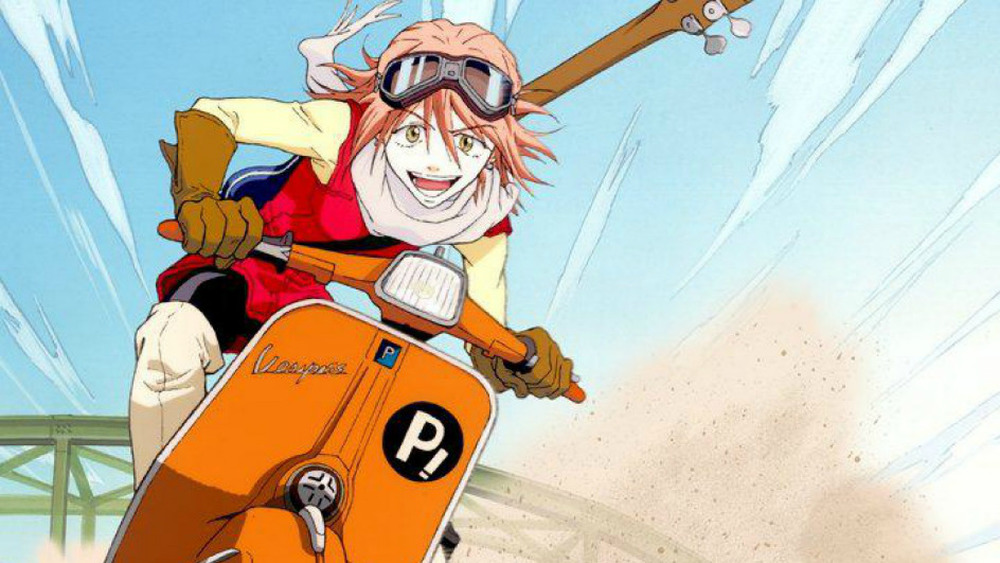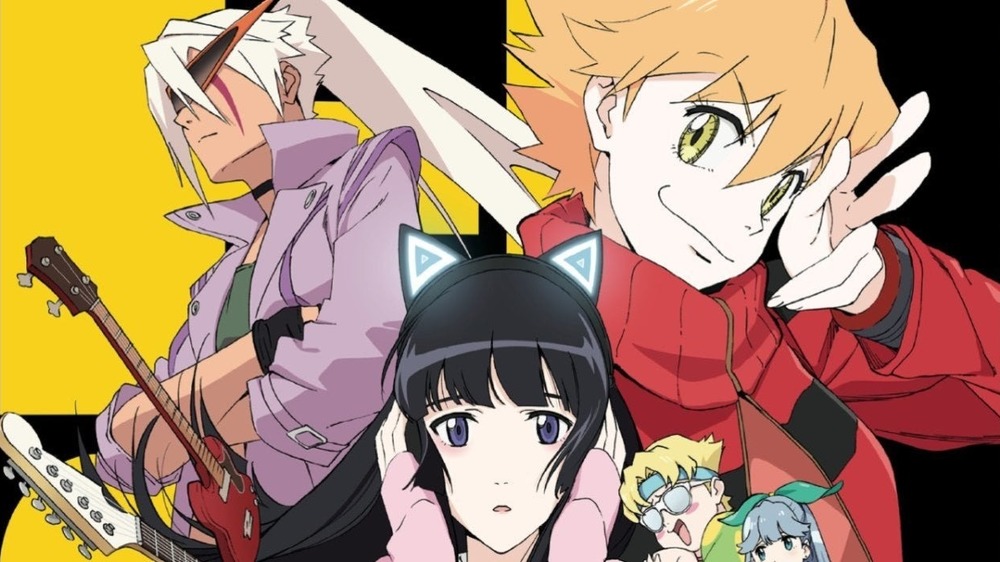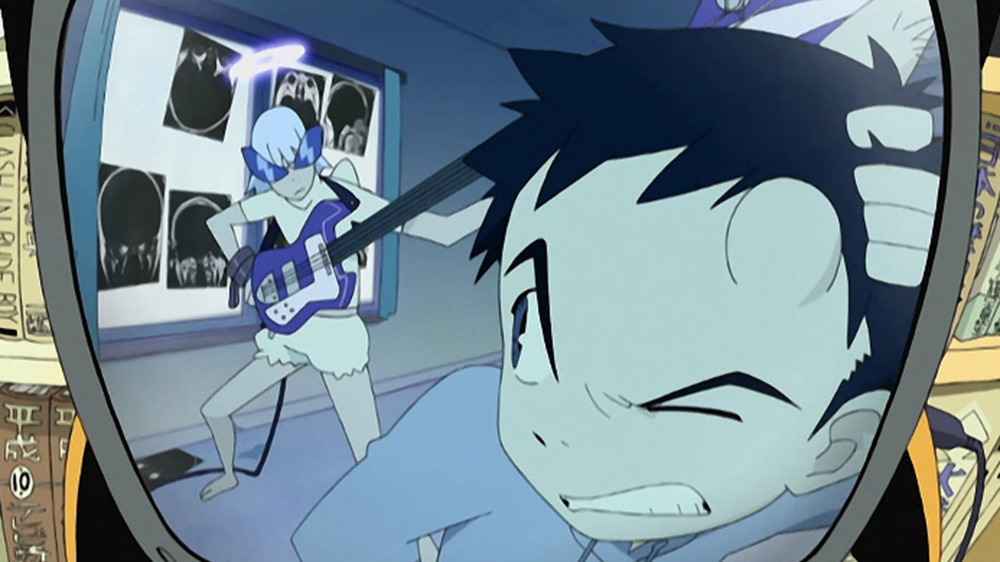The Ending Of FLCL Explained
FLCL is a popular Japanese anime that originally came out in 2000, and it's a far cry from the world of Studio Ghibli. Created and directed by Tsurumaki Kazuya and written by Enokido Yōji, the series focuses on a 12-year-old boy named Naota who gets run over by a woman — later revealed to be an alien — named Haruko riding in her Vespa, who then hits him in the head with her blue Rickenbacker 4001 guitar. The hit results in a huge horn protruding from Naota's forehead, and the show only gets weirder from there, as robots come out of the horn to fight each other, Haruko hunts down the powerful Pirate King, and a giant iron attempts to destroy Earth.
The first season of FLCL only had six episodes, but it made a huge impact on anime fans around the world. Everyone agrees that the show is wacky, unexpected, and hard to understand, but that's a trademark of many great anime, and it works for FLCL. At the same time, the series presents a strikingly poignant story of becoming an adult, both through vivid metaphors — like the horn — and more realistic situations that Naota goes through. More than 15 years after the series originally came out, two new seasons were released. Seasons 2 and 3, also known as FLCL Progressive and FLCL Alternative, are set years in the future and follow Haruko as she involves herself in the life of two teenage girls in her continuing quest to hunt down the aforementioned Pirate King, Atomsk.
But what exactly happens in this zany series, and what does it all mean? Here is the ending of FLCL — explained.
FLCL and Naota's journey to adulthood
FLCL focuses on Naota's transition to adulthood as Haruko messes with his life. She claims to be an investigator for the Galactic Space Patrol Brotherhood, sent to get Atomsk from the mysterious corporation called Medical Mechanica. All the while, her real goal is to absorb Atomsk and make him hers. Haruko and Naota find an ally in Canti, a friendly robot that spawns from Naota's horn. Haruko then uses Naota's naivety and his horn's portal powers to draw Atomsk out. Unfortunately, her plan goes awry when Atomsk takes Naota as a host, making it so she is unable to absorb him herself. In the end, Atomsk escapes, and Haruko leaves Earth to keep hunting him down.
As all this happens, Naota is simply struggling with the daily challenges of a 12-year-old boy. The series has a lot of explicitly sexual metaphors to represent Naota losing his innocence and becoming an adult. Over the first six episodes, Naota is manipulated by all the adults in his life, especially Haruko, who uses his affections to her advantage. Other characters in the story deal with their own personal problems, like Naota's brother's ex-girlfriend, Mamimi, who opens up to Naota about her parents being divorced and the loneliness she feels.
As Thrillist describes FLCL, "Like the teens at its center, it's defiant of authority, so often rejecting genre convention that trying to categorize it is a waste of time. [...] it represents the necessary rebellion of adolescence, the beginning of a path towards independence." Overall, FLCL is a surreal journey you really have to experience yourself to understand, and even then, it might be beyond comprehension.
FLCL Progressive and FLCL Alternative
In 2018, 18 years after the first season aired, Adult Swim teamed up with Production I.G., original character designer Yoshiyuki Sadamato, and FLCL creator Tsurumaki in a supervising role, to produce two new seasons of FLCL, titled FLCL Progressive and FLCL Alternative. The two seasons tell separate stories, with Haruko and her quest the connecting factor.
The new episodes are set years after Haruko and Naota's adventure. FLCL Progressive focuses on a 14-year-old girl named Hidomi who never takes off her headphones. She lives a relatively normal life until one day when a woman named Julia runs her over. Add to this a strange new teacher at her school named Haruko, and there's no stopping the trouble coming to her town. It turns out, Julia is actually a broken off part of Haruko. While Haruko wants to capture and love Atomsk, Julia wants to see the Pirate King freed. At the same time, Haruko needs Hidomi's help to battle Medical Mechanica, the corporation still trying to destroy Earth. Throughout the season, Hidomi discovers more about her powers, while also developing feelings for her classmate, Ide, who has a big crush on her.
In FLCL Alternative, the final season focuses on a 17-year-old girl named Kana who hates growing up. Haruko becomes a mentor to her, as Medical Mechanica begins a full assault on Earth. Like Naota and Hidomi before her, Kana has the ability to create a portal, and Haruko desperately needs to awaken that power in order to save the world in this final battle. At the end of the series, Haruko and Kana fail to save Earth and it's flattened by Medical Mechanica and their big iron. Thankfully, Kana is able to use her portal powers to create a wormhole to another planet, or possibly another Earth in a different reality. The heroes lost, but thanks to Kana saving Haruko and a bunch of other people, they can start over.
The symbolism in FLCL and the show's legacy
The biggest impact FLCL made on anime and TV in general is how it uses crazy imagery to portray a heartfelt story of love and growing up. While FLCL has a lot of great symbolism throughout the seasons, it's most notable in the original run. With Naota's horn, Haruko's guitar, and plenty of other visuals, there are a lot of sexual innuendos. This is certainly an anime series for a mature audience, that's for sure. Meanwhile Canti, Naota's robot friend, is a representation of Naota's older brother, Tasuku. who lives in the US. Naota sees him as the ideal adult and role model. The character of Canti is designed to be comforting and non-threatening, and his behavior is that of a caring guardian.
In a detailed thread on Reddit, one user named Rfowl009 goes into great detail about the symbolism they noticed in FLCL. They highlight what many believe to be the main theme of FLCL, which is Naota's journey through puberty, attempting to understand the confusing concepts of sexuality and maturity. As u/Rfowl009 put it, "we are confused by everything we see [in FLCL] because we see it through the eyes of a 12-year-old who is being confronted by sexuality and the escalating complications of life for the first time." This theme is supported by the visually extreme body horror, as well as consistent moments when characters like Haruko, Mamimi, and even Naota's father, use sex to hide from facing their true feelings. The show further explores these ideas in season 2 and 3 through Hidomi and Kana's character arcs.
It's safe to say that even with all of this analysis, all three seasons of FLCL are a conundrum that many people will find difficult to understand. Luckily, many fans claim that repeat viewings really help you make sense of the main storyline with Atomsk and Medical Mechanica, as well as the personal journeys of Naota, Haruko, and the other characters.



